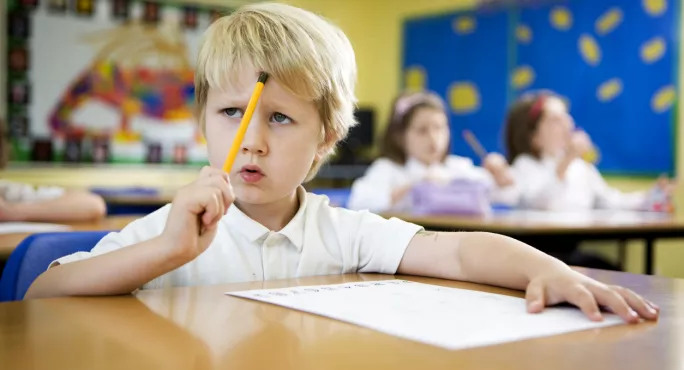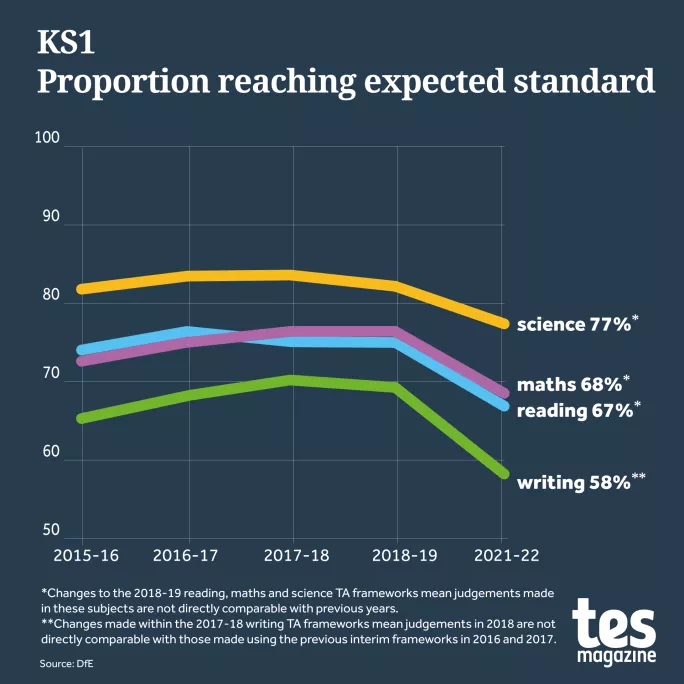Sats 2022: KS1 maths and literacy plummet after Covid

The proportion of pupils reaching the expected standard in reading, writing, maths and science by the end of key stage 1 has plummeted, reflecting fears that this cohort has been the worst hit by the impact of Covid on learning.
New statistics, published today by the Department for Education, show an 11 percentage point fall in writing compared with 2019, with just 58 per cent reaching the expected standard in 2022 against 69 per cent in 2019.
This year’s KS1 Sats results were the first to be published since 2019 because of the Covid pandemic.

The proportion reaching the expected standard in reading also fell to 67 per cent, compared with 75 per cent in 2019.
And just 68 per cent achieved the expected standard in maths, compared with 76 per cent in 2019.
- Key stage 2 Sats 2022: “Disappointing but expected” drop in attainment
- KS2 Sats: Only 1 per cent of schools achieved the DfE’s national 2030 target, study finds
- Sats 2022: STA sorry for “unacceptable” delays and missing papers
The proportion of pupils who met the expected standard in the phonics check at the end of Year 1 also fell compared with 2019. Just three-quarters of pupils met the expected standard by the end of Year 1, compared with 82 per cent in 2019 . This year’s figure is the lowest level of attainment for this age group since 2014.
Last month a headteachers’ leader warned that the rise in key stage 2 pupils working below the threshold for sitting Sats was “further evidence” of the ”government’s failure to fund a proper recovery plan”.
Key stage 1 Sats results: the disadvantage gap widens
Today’s results also show a widening of the attainment gap between disadvantaged pupils and their peers since before the pandemic.
In the writing teacher assessment, just four in 10 (41 per cent) of disadvantaged pupils reached the expected standard, down from 55 per cent in 2019.

And in reading, just over half (51 per cent) reached the expected standard, down from 62 per cent.
Meanwhile, in maths just over half (52 per cent) reached the expected level - a drop of 10 percentage points compared with 2019.
School and sector leaders have been warning of the impact of Covid on this cohort since schools were moved online in March 2020.
A report published in March of this year showed that the negative impact of Covid lockdowns on reading progress was greatest among KS1 pupils and particularly those in Year 1.
Jon Andrews, head of analysis at the Education Policy Institute think tank, said the data added to evidence that “the effects of the pandemic continue to be felt”, adding that the new prime minister and ministerial team must treat “addressing increasing inequality in our education system” as an “urgent priority”.
“Not only has overall attainment declined, but some of the country’s most vulnerable children are falling further behind their peers,” he said.
“We know that the disadvantage gap for 11-year-olds is now around the same level as it was in 2012, taking us back a decade. Today’s data for younger pupils highlights again the level of challenge in addressing that disparity.
“Only half of pupils from low-income backgrounds starting key stage 2 this year achieved the expected standard in each of reading and mathematics at the end of key stage 1, and just four in 10 pupils did so in writing.
“We have a new prime minister and a new ministerial team at the Department for Education, but they face many of the challenges that their predecessors have failed to address. Tackling the increasing inequality in our education system should be an urgent priority for them all. Given the challenges that loom ahead, ministers must focus on adequately resourcing schools and implementing a cross-government child poverty strategy.”
A DfE spokesperson said: “Today’s data shows why it is so important to keep rolling out our ambitious recovery plan across the country.
“We know the pandemic impacted children’s learning, and we are investing nearly £5 billion - with two million high-quality tutoring courses already started - to make sure children can catch up fast, and schools should continue to work with parents to make them aware of the additional support on offer.
“This targeted support for the pupils who need it most is vital as we keep moving towards our ambitious target of 90 per cent of children leaving primary school reaching the expected standard in reading, writing and maths by 2030.”
You need a Tes subscription to read this article
Subscribe now to read this article and get other subscriber-only content:
- Unlimited access to all Tes magazine content
- Exclusive subscriber-only stories
- Award-winning email newsletters
Already a subscriber? Log in
You need a subscription to read this article
Subscribe now to read this article and get other subscriber-only content, including:
- Unlimited access to all Tes magazine content
- Exclusive subscriber-only stories
- Award-winning email newsletters
topics in this article



